| 31 July |
• yesterday • tomorrow |
| Memorial of Saint Ignatius of Loyola, Priest |
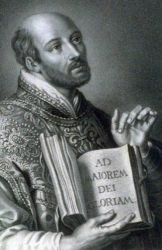
Inigo Lopez de Loyola
Born to the Spanish nobility. Youngest of twelve children. Page in the Spanish court of Ferdinand and Isabella. Military education. Soldier, entering the army in 1517, and serving in several campaigns. Wounded in the leg by a cannonball at the siege of Pampeluna on 20 May 1521, an injury that left him partially crippled for life. During his recuperation the only books he had access to were The Golden Legend, a collection of biographies of the saints, and the Life of Christ by Ludolph the Carthusian. These books, and the time spent in contemplation, changed him.
On his recovery he took a vow of chastity, hung his sword before the altar of the Virgin of Montserrat, and donned a pilgrim's robes. He lived in a cave from 1522 to 1523, contemplating the way to live a Christian life. Pilgrim to Rome and the Holy Land in 1523, where he worked to convert Muslims. In 1528 he began studying theology in Barcelona and Alcala in Spain, and Paris, France receiving his degree on 14 March 1534. His meditations, prayers, visions and insights led to forming the Constitutions of the Society of Jesus on 15 August 1534; it received papal approval in 1541. Friend of James Lainez, Alonso Salmerón, Nicholas Bobadilla, Simón Rodriguez, Blessed Peter Faber, and Saint Francis Xavier, the group that formed the core of the new Society. He never used the term Jesuit, which was coined as an insult by his opponents; the Society today uses the term with pride. He travelled Europe and the Holy Lands, then settled in Rome to direct the Jesuits. His health suffered in later years, and he was nearly blind at death.
The Jesuits today have over 500 universities and colleges, 30,000 members, and teach over 200,000 students each year.
1491 at Loyola, Guipuzcoa, Spain as Inigo Lopez de Loyola
31 July 1556 at Rome, Italy of fever
12 March 1622 by Pope Gregory XV
• soldiers
• Jesuit Order, Jesuits, Society of Jesus
• retreats (proclaimed on 25 July 1922 by Pope Pius XI)
• Spiritual Exercises (by Pope Pius XI)
• Basque country
• diocese of Bilbao, Spain
• military ordinariate of the Philippines
• álava, Spain
• Bizkaia, Spain
• Gipuzkoa, Spain
• Guipuscoa, Spain
• Guipúzcoa, Spain
• Vizcaya, Spain
• apparition of Our Lord
• book
• chasuble
• Holy Communion
Ignatius was passionately fond of reading worldly books of fiction and tales of knight-errantry. When he felt he was getting better from a wound he had received in battle, he asked for some of these books to pass the time. But no book of that sort could be found in the house; instead they gave him a life of Christ and a collection of the lives of saints written in Spanish.
By constantly reading these books he began to be attracted to what he found narrated there. Sometimes in the midst of his reading he would reflect on what he had read. Yet at other times he would dwell on many of the things which he had been accustomed to dwell on previously. But at this point our Lord came to his assistance, insuring that these thoughts were followed by others which arose from his current reading.
While reading the life of Christ our Lord or lives of the saints, he would reflect and reason with himself: "What if I should do what Saint Francis or Saint Dominic did?" In this way he let his mind dwell on many thoughts; they lasted a while until other things took their place. Then those vain and worldly images would come into his mind and remain a long time.
But there was a difference. When Ignatius reflected on worldly thoughts, he felt intense pleasure; but when he gave them up our of weariness, he felt dry and depressed. Yet when he thought of living the rigorous sort of life he knew the saints had lived, he not only experienced pleasure when he actually thought about it, but even after he dismissed these thoughts, he still experienced great joy. Yet he did not pay attention to this, nor did he appreciate it, until one day, in a moment of insight he began to marvel at the difference. Then he understood his experience. Thoughts of one kind left him sad, the others full of joy. - from the life of Saint Ignatius, from his own words, by Luis Gonzalez
Do not let any occasion of gaining merit pass without taking care to draw some spiritual profit from it; as, for example, from a sharp word which someone may say to you; from an act of obedience imposed against your will; from an opportunity which may occur to humble yourself, or to practice charity, sweetness, and patience. All of these occasions are gain for you, and you should seek to procure them; and at the close of that day, when the greatest number of them have come to you, you should go to rest most cheerful and pleased, as the merchant does on the day when he had had most chance for making money; for on that day business has prospered with him. - Saint Ignatius Loyola
If God causes you to suffer much, it is a sign that He has great designs for you, and that He certainly intends to make you a saint. And if you wish to become a great saint, entreat Him yourself to give you much opportunity for suffering; for there is no wood better to kindle the fire of holy love than the wood of the cross, which Christ used for His own great sacrifice of boundless charity. - Saint Ignatius Loyola
https://catholicsaints.info/saint-ignatius-of-loyola/
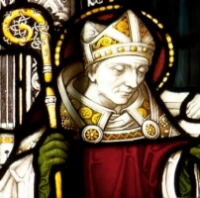
Germain of Auxerre
Born to a noble Gallic family, the son of Rusticus and Germanilla. Studied general topics in Arles and Lyon in France, and rhetoric and civil law in Rome, Italy. Successful lawyer for several years. Married to Eustachia, a member of the nobility with close ties to the emperor. Imperial governor of part of Gaul, based in Auxerre.
He led a worldly life, and frequently hung hunting trophies on an enormous, ancient tree that had been an object of worship by local pagans. This led to condemnation by Saint Amator of Auxerre, who said he set a terrible example, and was leading people back to their pagan origins. Germain ignored him, so Amator cut down the tree and burned the trophies. Germain tracked down Amator, intending to kill him; Amator forced the tonsure on Germain, made him a deacon, and told him to live as one destined to be a bishop. Germain took the whole incident to be an action of the Holy Spirit, and changed completely. He devoted himself to prayer, study and charity. When Saint Amator died soon after, Germain was unanimously chosen bishop of Auxerre on 7 July 418.
His administrative skills served Germain well in his new position. He gave away his property to the poor, and lived as a pauper. Converted and trained Saint Camilla. Dispatched with Lupus of Troyes to the British Isles by Pope Celestine I in 429, he fought the Pelagianist heresy in Britain. While en route he met the young child Saint Genevieve. One early document says that Saint Patrick was part of Germain's entourage. Once the Pelagians were in retreat, Germain travelled Britain, preaching and setting up seminaries; he trained Saint Brieuc of Brittany for his mission.
Germain returned to France, obtained tax relief for the people of his diocese, and built the church of Saint Alban in Auxerre. In 447 he returned to Britain with Severus of Trèves. They evangelized in Wales, and helped the Britons with a battle over invading Saxons and Picts. When he returned to Gaul, Germain found that the Armoricans in Brittany were going to be severely punished for a rebellion against the empire. He obtained a stay of execution for them until he could appeal to the emperor. In Ravenna, Italy he met with Saint Peter Chrysologus, pled his case to empress Galla Placidia, obtained pardon for the people, and died there a short time later.
c.378 at Auxerre, France
• 31 July 448 at Ravenna, Italy of natural causes
• interred in the Oratory of Saint Maurice, Auxerre, France
• re-interred in the church of Saint Germain that was built by Queen Clotilda on the site of the Oratory
• body found intact when re-located in the church several centuries later
• in 1567 the Huguenots desecrated the shrine and threw out the relics
• relics in Saint Marion abbey are reported to be Saint Germain's, but this cannot be proven
• bishop carrying a knife
• bishop trampling on a judge
Auxerre, France
https://catholicsaints.info/saint-germanus-of-auxerre/
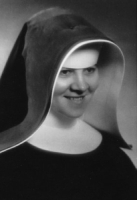
Zdenka Schelingová
One of ten children born to Pavol Schelingová and Zuzana Pániková. She received her basic education locally, and later studied nursing and radiology. Known as a pious child, she early felt a call to religious life. At age 15 she requested entry to the Congregation of the Sisters of Charity of the Holy Cross, and made her first vows on 30 January 1937, taking the name Zdenka.
Nurse at a hospital in Humenné and then in Bratislava where she worked in radiology. While she was assigned to Bratislava, the Communists seized power and began a systematic persecution of the Church and its members. Many were arrested and tortured for their faith, and some of these were brought to Zdenka's hospital for treatment. In early 1952 Zdenka helped a condemned priest escape from certain death in Siberia. On 29 February 1952 she tried to help three priests and three seminarians escape, but she failed, and was arrested, tortured, and sentenced to twelve years in prison and ten years of loss of civil rights.
For the next three years she was shipped from prison to prison, regularly beaten and tortured; some of her wounds were never permitted to heal. She was released from prison on 16 April 1955, nine years early, so that she would not die on the government's hands. Due to police harassment, she was turned away from her congregation's motherhouse, and from the hospital where she used to work. She died a few months later, her health broken by the abuse, but ever loyal to her faith.
25 December 1916 in Krivá na Orave, Zilinský kraj, Slovakia
31 July 1955 in Trnava, Trnavský kraj, Slovakia
14 September 2003 by Pope John Paul II at Bratislava, Slovak Republic
I want to do God's will without paying attention to myself, my comfort or my rest. - Sister Zdenka
Yes, "God so loved the world that he gave his only Son." We admire - overwhelmed and gratified - the breadth and length and height and depth of the love of Christ which surpasses all knowledge! O Crux, ave spes unica! Certainly, it was meditation on this great and wonderful mystery that sustained Blessed Bishop Vasil' Hopko and Blessed Sister Zdenka Schelingová in their choice of the consecrated life and especially in the sufferings endured during their terrible imprisonment. Both shine before us as radiant examples of faithfulness in times of harsh and ruthless religious persecution. Bishop Vasil' never repudiated his attachment to the Catholic Church and to the Pope. Sister Zdenka did not hesitate to risk her life so as to assist God's ministers. Both faced up to an unjust trial and an ignoble condemnation, to torture, humiliation, solitude, death. And so the Cross became for them the way that led them to life, a source of fortitude and hope, a proof of love for God and man. O Crux, ave spes unica! - Pope John Paul II
https://catholicsaints.info/blessed-cecilia-schelingov/
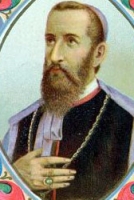
Justin de Jacobis
Justin grew up a pious youth in the city of Naples, Italy and joined the Vincentians at age 18. Ordained on 12 June 1824 in the Congregation of the Mission. Noted for his preaching skills, especially among the rural poor. Helped found a Vincentian house at Monopoli, Italy. Superior at Lecce, Italy. Worked in with the sick in the 1836-1837 cholera epidemic in Naples.
Appointed Prefect, Vicar Apostolic, and missionary to Adua, Ethiopia on 10 March 1839, beginning the African missionary work that would consume the rest of his life. The people were primarly a combination of pagan, Islamic, and Coptic Christian, and foreigners were not welcomed by authorities, civil or religious. Justin learned the language, lived with the people, and worked to improve relations at the local level. He tried to have one of his monks appointed Patriach of the Ethiopian church, but failed.
Justin returned to Rome, Italy for consultations with the Pope Gregory XVI, trying (and failing) to get some of the Ethiopian religious leaders to come with him. In 1846 he returned to Ethiopia to found a college and seminary at Guala. This work, and other Catholic missionary efforts, caused a backlash in the Ethiopian Church; Catholicism was banned, and Bishop Massaia was forced to flee to Rome. Despite exhortations for his death, Justin remained, and became an underground missionary, caring for converts. Consecrated as titular bishop of Nilopolis and vicar apostolic of Abyssinia, Ethiopia on 6 July 1847. Given authority to administer the sacraments in the Ethiopian rite. By 1853 he had consecrated twenty priests, made 5,000 converts, and was able to re-open the college at Guala.
In 1860, Kedaref Kassa became the Ethiopian King Thedore II with the backing of Abuna Salama, Patriarch of the Ethiopian Church. In gratitude, he prohibited Catholicism, and De Jacobis was imprisoned for several months. He was then force-marched to the area of Halai in southern Eritrea, spending his remaining months in missionary work along the Red Sea.
He is considered an apostle to Africa, and the founder of the Abyssinian mission. Blessed Ghebre Michael is among the estimated 12,000 converts he made in his time.
9 October 1800 at San Fele, Luciana, Italy
• 31 July 1860 on the side of a road near Halai of a tropical fever in the valley of Alghedien Zula, Semenawi Keih Bahri, Eritrea while on a missionary trip
• buried in a church at Hebo
26 October 1975 by Pope Paul VI
God chose him to be a teacher even more by example than by words. - Cardinal Messaia
https://catholicsaints.info/saint-giustino-de-jacobis/
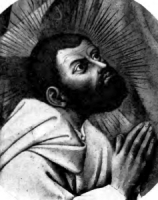
John Columbini
Wealthy, greedy, ambitious, and ill-tempered son of a patrician family. Married layman, and father of two children, his son Peter and daughter Angela. First magistrate (Gonfalionere) of Siena, Italy. With his family and friends, he alternated between bouts of anger and consequent periods of mortification and self-loathing. Converted to the faith while reading the story of the conversion of Saint Mary of Egypt. Reformed his personal and business life; visited hospitals, tended the sick, gave to the poor, personally tending to the poorest and most forgotten in his society.
Several years into his new life, John's son died, and his daughter became a nun. He established an annuity that allowed his wife to live in comfort, and used the rest of his wealth to endow a hospital and two convents. From then on he lived in poverty, begging for his bread from day to day. He soon attracted followers, many of them young men from wealthy families who were disillusioned with their lives, and felt a call to God and a call to give away their wealth. The patrician class demanded John's exile as he was leading the city's most promising young men to "folly."
Founded a small group of laymen, called the Jesuati (Gesuati or Jesuats) after their habit of saying "Praise be to Jesus Christ" about everything. They were devoted to penance and charity, and had a special devotion to Saint Jerome. The group received approval by Pope Urban V in 1367, just 37 days before John's death. It survived until 1668 when, because of abuses that had crept in over the years, it was suppressed by Pope Clement IX. A sister organization, the Jesuatesses or Sisters of the Visitation of Mary was founded around 1367 by John's cousin, Blessed Catharine Colombini; it survived until 1872 when it disappeared due to attrition.
c.1300 at Siena, Italy
31 July 1367 of natural causes while on the road to Acquapendente, Italy
by Pope Gregory XIII
• barefooted man wearing a white habit, a beard, a dark leather belt, and with the letters IHS on his chest
• man caring for the sick
• man grinding riches beneath his feet
https://catholicsaints.info/blessed-john-colombini/
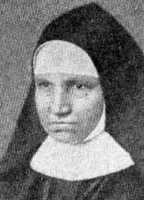
• Mother Alphonse-Marie
• Sister Alphonse-Marie
• Alfonsa Maria Elisabeth Eppinger
• The Niederbronn Ecstatic
Eldest of eleven children born to a poor farm family. Élisabeth was a sickly but very pious child. In 1846 she had the first of a series of visions, including of Jesus Christ. The combination led her to her belief that suffering could block a person from experiencing God's love, and relieving suffering could free a person to easier find God. When Bishop Andreas Raess examined her in July 1848 and came away convinced that she was called to serve the poor and sick.
On 28 August 1849, in Niederbronn-les-Baines, France, Élisabeth founded the Sisters of the Holy Redeemer to care for the impoverished sick in their own homes. She placed it under the patronage of Saint Alphonse Maria Liguori, and served as the first superior of the Congregation. She made her religious vows on 2 January 1850, taking the name Alphonse-Marie. The Congregation received approval of Emperor Napoleon III in 1854; later that year they worked with victims of a cholera pandemic. They were praised by Pope Pius IX in 1863 by which point there were 700 Sisters in 83 houses; they received full Vatican approval in 1866, and continue their good work today in France, Germany, Austria, Hungary and Argentina.
9 September 1814 in Niederbronn-les-Baines, Bas-Rhin, France during the Bourbon Restoration
• 31 July 1867 in Niederbronn-les-Baines, Bas-Rhin, France during the Second French Empire of natural causes
• remains re-interred on 8 November 1950 as part of the canonization investigation process
• 8 September 2018 by Pope Francis
• beatification recognition celebrated in Strasbourg, France
Sisters of the Holy Redeemer
https://catholicsaints.info/blessed-elisabeth-eppinger/
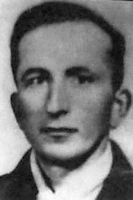
12 June as one of the 108 Martyrs of World War II
The son of farmers, Franciszek was a married layman and father in the diocese of Kalisz, Poland; he and Józefa Kobylka were married in 1901, lived in Kuczowola, Poland, and had seven children. When Józefa died of natural causes, Franciszek married Józefa Nosal and moved to Takomysl, Poland. When all the priests in the area were arrested in the Nazi occupation in World War II, Franciszek began teaching religion to children, preparing them for their First Communion. This led to his arrest by the Gestapo who imprisoned him in Kalisz, Poland and abused him to death over the course of ten days. Martyr.
26 January 1882 in Popów, Szczytniki, Kalisz, Poland
tortured to death on 31 July 1944 in Kalisz, Poland
13 June 1999 by Pope John Paul II at Warsaw, Poland
https://catholicsaints.info/blessed-franciszek-stryjas/

• Helen of Skovde
• Elin...
Born to the Swedish nobility. She married young, and was the mother of one daughter. Built the church of Skofde, Sweden. Widowed early in her marriage, after which she gave away most of her fortune to the poor. Helen's son-in-law was murdered by his own servants because of his cruelty. Soon after, Helen left on a pilgrimage, and when the son-in-law's family arrived to investigate the death, the servants blamed it on Helen, claiming her pilgimage was a cover for fleeing justice. The in-laws believed the story, tracked her down, and killed her.
12th century Vastergotland, Sweden
• murdered c.1160
• miracles reported at her tomb
1164 by Pope Alexander III
• falsely accused people
• in-law problems
• martyrs
• Vastergotland, Sweden
• widows
https://catholicsaints.info/saint-helen-of-skofde/
29 October as one of the Martyrs of Douai
Raised Protestant. Educated at Cambridge University. Anglican minister. A near-fatal illness caused him to re-examine his life and ministery, and with the support of his brother, William, he converted to Catholicism in 1568. Studied in Rheims, France, and was ordained on 25 March 1581. Father Everard sailed for England on 24 April 1581 with a plan to minister to covert Catholics. Captured soon after in the Marshalsea prison while visiting Catholic prisoners. Lodged in Newgate prison in 1581. Found guilty of the crime of persuading others to join the Catholic Church and refusing to accept the queen as head of the Church; martyr.
Northamptonshire, England
hanged, drawn and quartered on 31 July 1581 at Tyburn, London, England
29 December 1886 by Pope Leo XIII (cultus confirmation)
Oh happy day! - Blessed Everard's dying words
https://catholicsaints.info/blessed-everard-hanse/
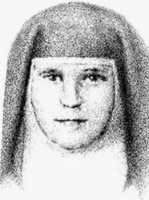
• Daniela de San Bernabé
• Daniela of Saint Barnabas
Joined the Carmelite Missionaries in 1910, began her formal novitiate at Gracia-Barcelona, Spain in 1915, her profession in 1916, and her perpetual vows in 1921. Had a great devotion to the Sacred Heart of Jesus and Our Lady of Mount Carmel. Worked at the Las Corts mental hospital, the Badalona Asylum, the Amparo de Santa Lucia house for the blind in Barcelona, and then did home care for the sick from the Carmelite motherhouse in Barcelona. Martyred by the Communist “Red Committee” in the Spanish Civil War.
4 April 1890 in Berriatúa, Vizcaya, Spain
shot on 31 July 1936 at the L’Arrabassada highway, Barcelona, Spain
28 October 2007 by Pope Benedict XVI
https://catholicsaints.info/blessed-vicenta-achurra-gogenola/
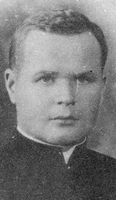
12 June as one of the 108 Martyrs of World War II
Priest of the archdiocese of Warsaw, Poland, serving in the parish of Kutno where he was know for ministry and assistance to the poor. Arrested in October 1941 by the Gestapo and imprisoned in the Dachau concentration camp during the Nazi occupation of Poland in World War II. There he worked to minister to fellow prisoners until his death. Martyr.
28 September 1900 in Izdebno Koscielne, Grodzisk Mazowiecki, Poland
of starvation and abuse on 31 July 1942 at Dachau concentration camp in Oberbayern, Germany
13 June 1999 by Pope John Paul II at Warsaw, Poland
https://catholicsaints.info/blessed-michal-oziebijowski/
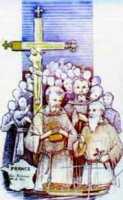
Priest in the diocese of Limoges, France. Imprisoned on a ship in the harbor of Rochefort, France and left to die during the anti-Catholic persecutions of the French Revolution. One of the Martyrs of the Hulks of Rochefort.
11 January 1752 in Saint-Yrieix, Haute-Vienne, France
31 July 1794 aboard the prison ship Deux-Associés, in Rochefort, Charente-Maritime, France
1 October 1995 by Pope John Paul II
https://catholicsaints.info/blessed-jean-francois-jarrige-de-la-morelie-de-breuil/
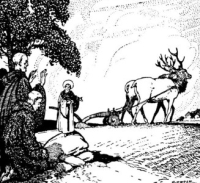
the Pygmy Saint
Related to King Alfred the Great. Monk of Glastonbury Abbey. Priest. Sacristan. Hermit in Cornwall, England. Reports describe him from being 4 foot tall down to a mere 15 inches. Spent much of his day up to his neck in a well during his devotions. Neot had a strange way with animals and birds, and worked miracles with them.
• 877 of natural causes
• some relics at Saint Neot's church, Cambridgeshire, England
• some relics at the abbey of Bee, Normandy, France
fish
fish
https://catholicsaints.info/saint-neot/
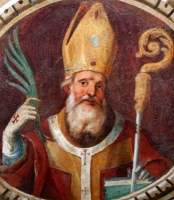
Apostle of the Po Valley
Educated in Rome, Italy by Pope Saint Telesphorus. Priest. Bishop of Milan, Italy for over 50 years. Evangelized throughout his diocese, making untold converts. Suffered in but survived the persecutions of Marcus Aurelius. Martyred in the persecutions of Commodus.
Greek
• drowned in a well c.190 in Milan, Italy
• buried under the altar of his church in Milan
https://catholicsaints.info/saint-calimerius-of-milan/

Fabio
Soldier. Martyred in the persecutions of Diocletian for refusing to carry a standard with emblems of idols.
beheaded in 300 in Caesarea, Maurentania, North Africa
https://catholicsaints.info/saint-fabius-of-caesarea/
Bishop of Tagaste, Numidia in North Africa (modern Souk Ahrus, Algeria). Tortured extensively to betray the hiding place of one of his flock; he refused.
https://catholicsaints.info/saint-firmus-of-tagaste/
350 monks massacred by heretics for their adherence to orthodox Christianity and the decrees of the Council of Chalcedon.
517 in Syria
https://catholicsaints.info/martyrs-of-syria-31-july/
Martyr.
https://catholicsaints.info/saint-dionysius-the-martyr/
Martyr.
https://catholicsaints.info/saint-democritus/
Martyr.
https://catholicsaints.info/saint-secundus/
Thousands of people were murdered in the anti-Catholic persecutions of the Spanish Civil War from 1934 to 1939. I have pages on each of them, but in most cases I have only found very minimal information. They are available on the CatholicSaints.Info site through these links:
• Blessed Ciriaco Olarte Pérez de Mendiguren
• Blessed Dionisio Vicente Ramos
• Blessed Francisco Remón Játiva
• Blessed Jaume Buch Canals
• Blessed Maria Roqueta Serra
• Blessed Miguel Francisco González-Díez González-Núñez
• Blessed Miguel Goñi Ariz
• Blessed Prudencio Gueréquiz y Guezuraga
• Blessed Segundo de Santa Teresa
• Blessed Teresa Subirá Sanjaume
• Our Lady of Consolation
• Martyred Spanish Carmelites
• Catherine of Leuven
• Emanuele Phung
• Francis of Milan
• Girolamo Michele Calmell
• Peter Doan Cong Quy
• Tertullinus of Rome
CatholicSaints.Info Portable Edition